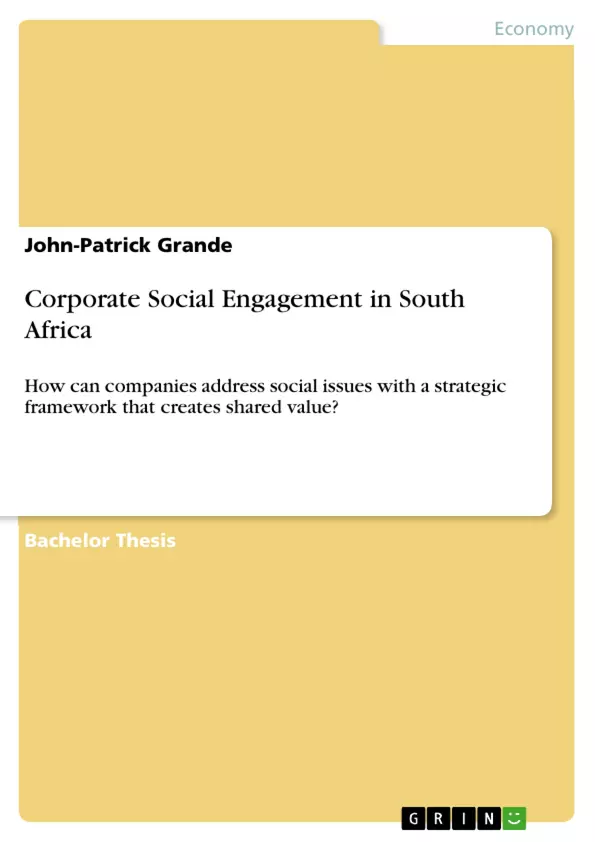The best motivational basis for writing an insightful and useful thesis is indisputably personal interest. Therefore, I have chosen this topic, as there are several reasons why I regard this to be an interesting field of research.
Firstly, I myself have developed an interest for the country of South Africa, as I have spent my semester abroad at the DUT in Durban. This results in deeper insight into the society at hand and the people who having to deal with the social problems. As an international business student one consequently questions the way business is done in this country and the means of corporate engagement. Resulting from our Business Ethics class, in which we were given the assignment to write about an ethical issue in a foreign country, I have already acquired knowledge about the ethical landscape in South Africa. I realized that this field is especially difficult and broad regarding the Apartheid stricken country. Discussions and meetings with South African locals in Durban who have a certain insight into the governmental and/or business practices underlying the theory have then further deepened my desire to pursuit further research in this direction.
As to the scientific relevance, corporate engagement still constitutes an immensely important role and even more so in emerging economies. So companies are constantly looking for ways of improving their responsible behavior in society. Companies seldom have the desire to analyze all the concepts available in the pool of corporate social engagement approaches. This thesis is supposed to give companies a guideline on how to successfully integrate one of these concepts and thereby generate social and economic leverage in the environment of a developing economy that is South Africa.
Inhaltsverzeichnis (Table of Contents)
- ENSURANCE
- LIST OF ABBREVIATIONS
- LIST OF FIGURES
- INTRODUCTION
- PERSONAL MOTIVATION, RELEVANCE AND HYPOTHESIS
- METHODOLOGY
- LIMITATIONS AND TIMEFRAME
- THEORETICAL FRAMEWORK
- DEVELOPMENT OF CORPORATE ENGAGEMENT
- TERMINOLOGY OF PORTER & KRAMER
- Corporate Philanthropy
- Corporate Philanthropy and Competitive Advantage
- Competitive Advantage and CSR
- Creating Shared Value
- RESEARCH
- SOUTH AFRICAN CONTEXT
- EXPLANATION OF COMPANY SELECTION
- COMPANY ANALYSIS
- DIAGRAMMATIC OVERVIEW
- BEST PRACTICES
- Nestlé
- Vodacom
- SABMiller
- Coca-Cola
- Anglo American
- Woolworths
- Standard Bank
- BMW
- GlaxoSmithKline
- CONCLUSION
- CRITIQUES
- RECOMMENDATION
- OUTLOOK
- The evolution of corporate engagement and its impact on social issues.
- The application of Porter & Kramer's framework for creating shared value in South Africa.
- The relationship between corporate social responsibility and competitive advantage.
- The best practices of companies in South Africa that demonstrate a commitment to social engagement.
- The potential for shared value creation through strategic approaches to corporate social engagement.
Zielsetzung und Themenschwerpunkte (Objectives and Key Themes)
This thesis aims to explore how companies operating in South Africa can effectively address social issues through strategic frameworks that create shared value. It investigates the development of corporate engagement and examines the terminology of Porter & Kramer, focusing on concepts such as corporate philanthropy, competitive advantage, corporate social responsibility, and creating shared value. The research analyzes the South African context and specific case studies of companies to understand their approaches to social engagement.Zusammenfassung der Kapitel (Chapter Summaries)
The introduction sets the stage for the thesis by presenting personal motivation, the research hypothesis, and the methodology used. It also addresses limitations and timeframe for the research. The theoretical framework delves into the evolution of corporate engagement, outlining the terminology of Porter & Kramer and their concept of Creating Shared Value. The South African context is examined, and the rationale for company selection is explained. Chapter 5 analyzes the case studies of various companies operating in South Africa, including their approaches to social engagement and best practices.Schlüsselwörter (Keywords)
This thesis examines key terms and concepts related to corporate social engagement in South Africa. Some of these include Corporate Social Responsibility (CSR), Creating Shared Value (CSV), Corporate Social Investment (CSI), Bottom of the Pyramid (BOP), competitive advantage, and strategic frameworks.- Arbeit zitieren
- John-Patrick Grande (Autor:in), 2014, Corporate Social Engagement in South Africa, München, GRIN Verlag, https://www.grin.com/document/284642



